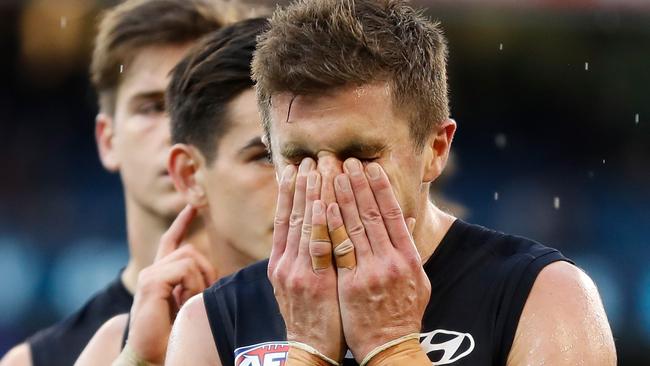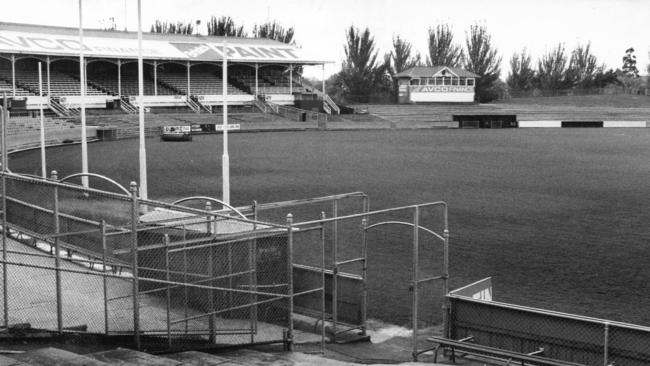How Carlton turned its footy failures into a financial success
A clever move to reward loyal fans after the club’s wooden spoons has paid off handsomely for Carlton, which made a whopping profit last year. And it’s not just fans and pokies bringing in the cash.

Carlton
Don't miss out on the headlines from Carlton. Followed categories will be added to My News.
It took 138 years before Carlton collected its first wooden spoon in 2002. Since then it has taken four more.
But something is happening lately down at the Blues.
Since again finishing last in 2018 fans have rallied, and delivered the biggest membership in the club’s history.
The club is now turning very healthy profits, booking a whopping net profit of $6.3m last year – up from $699,000 the year before.
It is investing in its footy team again, redeveloping Ikon Park and paying off debt.
Is the long-struggling former power club about to take its place in the top tier again?
WHERE DOES CARLTON GET ITS CASH?
Last year the Blues revealed they had increased revenue to $71.2m, up from $62.8m the year before.
Of this $8.4m leap, government grants for Ikon Park redevelopment accounted for about $3.8m.
The rest of the jump came from loyal fans signing back up as members, and an improved business model.
Carlton – despite another wooden spoon in 2018 – in 2019 hit a record membership of 64,269.
This is up from 56,005 in the previous year, making it the biggest year-on-year membership jump in the club’s history.
This year the club already has 10,000 more members than it had at the same time last year.
SO HOW DID THEY DO IT?
A major shake-up of the administration by president Mark LoGiudice at the end of 2017 included Cain Liddle being brought in as chief after winning praise for his work as chief customer officer at Richmond.
A large part of this is the new administration is reaching out to supporters, converting them to members and giving them better bang for buck (for example, upgrading every member for free at the end of 2018.)
It seems to be working.
Average home attendances increased last year from 31,775 in 2018 to 46,730 last year – this was the biggest percentage growth across the AFL for the season.
The cash granted from members and supporters went up $4.1m.

The club has strong commercial deals with Virgin Australia, Hyundai, Visy, La Trobe University, Ikon Services, MC Labour, CUA, On Time, Lincoln Indicators and Austbrokers.
It recently announced a 10 year apparel partnership with Puma.
It appears Puma are being selective in forming long term partnerships with what it believes are power clubs (recall the Richmond Puma deal as well).
It is rumoured the Carlton-Puma deal is worth around $10m over the decade. That would make it one of the biggest on-field apparel deals any AFL club has done.
AFL income dropped slightly to $13.8m from $14m the year before, while merchandise rose to $1.8m from $1.3m.
The cash the club makes from its “club hospitality venues” (which includes pokies) was $19m, slightly down from $19.6m.
Interestingly the revenue stream from “non traditional” sources – such as the Carlton in Business program and the new Carlton College of Sport – leapt more than 100 per cent.
This grew from $730,000 to $1.5m in one year.
It is believed the club are looking to these as lucrative long-term opportunities to insulate the club against on-field performance.
WHAT DOES IT COST TO RUN CARLTON?
Carlton has been servicing debt since 1996.
The clubs $6.4m debt was reduced to $4m in 2019 and Liddle is confident that the club will entirely eliminate it’s historical debt within the next year or two.
That would make it debt free for the first time in 24 years. That should be a cleansing moment for fans who have been through a lot.
But it costs a lot to run a big club, and Carlton’s football department costs increased to $26.3m last year, up from $25.4m the year before.
It is understood the rivers of revenue are being put back into the club’s football programs – that is the players, staff and coaches that can help a team win.
It has to be remembered Carlton’s AFL football program needed to rebound from being the most under-invested program across the league from 2016 to 2018.


In 2020 it is believed it will be in the top three clubs for football department spend.
The additional investment in the AFL and AFLW football departments from 2018 to 2020 is proposed to be in excess of $4.5 million annually and has almost entirely been self-generated through increased club revenues.
Club hospitality venue costs were flat on $16m while commercial activities were $12m up from $10.4m.
Being asset-rich can be expensive, and Carlton’s spiritual home at Princes Park – with parts of it being heritage listed – takes cash to maintain.
Significantly for the club, Carlton have secured $35m in government funding for a complete redevelopment of Ikon Park.
This money will help consolidate Ikon Park’s position as a homebase for AFLW (a key growth area for the entire code in coming years) while also expanding and improving the elite training facilities.
It is understood the club would prefer not to go into debt to help pay for the Ikon redevelopment – instead using club revenue to pay its way.
WHAT DANGER DOES CARLTON FACE?
It’s pretty rare to have your highest ever membership a year after getting a wooden spoon, so Carlton know the fans are showing more than a little bit of patience with the rebuild.
But with the knowledge cash is being put into the footy department fans will be hoping for even better from their stars like Cripps and Betts this year.
As we all know winters in Melbourne can be pretty dark if you feel your team is underperforming. Any drop away in fans would hurt the revenues.
READ MORE:
BOMBERS SECRET FINANCIAL WEAPON
The club is wise enough to know it needs to have “non traditional” revenue that is not impacted by whether the team is winning or losing. While this is growing strongly it still has a way to go before it is the club’s financial backstop.
Carlton have progressed far along the tightrope of rebuilding, but it is always precarious.
